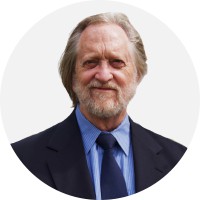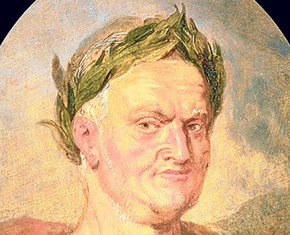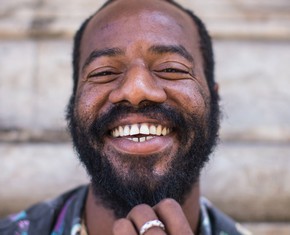The views expressed in our content reflect individual perspectives and do not represent the authoritative views of the Baha'i Faith.
Like Christ before him whose prophecies he fulfills, Muḥammad’s early life as a caravan driver did not for the most part seem to foreshadow his station as a prophet of God.
Muhammad’s father died before he was born, and his mother died when Muhammad was six. He was then passed to the care of his paternal grandfather. When the grandfather died two years later, Muhammad was given to the care of his uncle Abu Talib, head of the Banu Hashim tribe and a merchant and trader by profession.
At age 10, while accompanying his uncle on a journey to Syria, Muhammad first encountered someone who seemed to discern in him a sign of future greatness. In the Syrian town of Bosra, Muhammad met Bahira, a Christian monk. From his study of Christian scripture, Bahira recognized in Muhammad the one who would fulfill Christ’s prophecy about sending a “Comforter” or Paraclete, as promised in the Gospel of John, chapter 14, verse 26:
But the Comforter, which is the Holy Ghost, whom the Father will send in my name, he shall teach you all things, and bring all things to your remembrance, whatsoever I have said unto you.
RELATED: The Seal of the Prophets, Unsealed
This allusion to the childhood of Muhammad immediately calls to mind the single episode, cited in Luke 2:39–52, regarding the childhood of Jesus. At age twelve Jesus was found in the temple by his frantic parents, who had thought their young child to be lost:
And it came to pass, that after three days they found him in the temple, sitting in the midst of the doctors, both hearing them, and asking them questions. And all that heard him were astonished at his understanding and answers. And when they saw him, they were amazed, and his mother said unto Him, “Son, why hast thou thus dealt with us? Behold, thy father and I have sought thee sorrowing.”
And he said unto them, “How is it that ye sought me? Wist ye not that I must be about my Father’s business?” And they understood not the saying which He spake unto them.”
While Jesus was well aware of his station before the age of 30, the episode which marks the beginning of Muhammad’s first intimations of his revelation and mission did not occur until he was 40 years old.
In the meantime, Muhammad had acquired the nickname of “Al Amin” (“The Trusted One”) because of his honesty and upright character. He also had a felicitous marriage to a wealthy widow named Khadijah, whom he married when he was twenty-five and she was forty.
Sometime during the next decade, Muhammad began to make it a practice to spend several weeks each year meditating in a cave on Mt. Hira. In the year 610, the Angel Gabriel appeared to Muhammad and commanded him to recite verses. Over the next three years, Muhammad developed a regimen of prayer and meditation, parallel thematically to Christ’s forty days of meditation and reflection in the desert following the intimation of his revelation.
During this period, the revelations continued and in time Muhammad began to preach the messages revealed to him. The first to believe in his station as both a prophet (nabi) and a divine messenger (rasul) was his wife Khadijah, and the second was his young cousin Ali, who was but 10 years old at the time. Ali would later marry Muhammad’s daughter Fatimah and, according to Shi‘ih and Baha’i belief, would become the designated successor to Muhammad, or the first Imam.
While the spiritual, social, and political processes that followed these initial stirrings of the revelation of Muhammad are well worth recounting, the date usually given for the beginning of Islam is 622, when, under threat of death from enemies of his teachings in Mecca, the 52-year-old prophet emigrated from Mecca to Medina with the help of Ali, where he began to establish laws, to secure pacts for peaceful relationships among the various warring tribal groups, and to establish the first Moslem ummah or community. The Baha’i writings, specifically Abdu’l-Baha’s book Some Answered Questions, detail the difficult, daunting task that forging this unity represented:
Briefly, Muhammad appeared in the desert of Hijaz in the Arabian Peninsula, which was a treeless and barren wilderness: sandy, desolate in the extreme, and in some places, such as Mecca and Medina, exceedingly hot. Its inhabitants were nomads, had the morals and manners of desert-dwellers, and were entirely bereft of knowledge and learning. … Infer then from this the conditions prevailing among the people to whom Muhammad was sent! …
It was in such a land and amid such barbarous tribes that an illiterate Man brought forth a Book in which the attributes and perfections of God, the prophethood of His Messengers, the precepts of His religion, and certain fields of knowledge and questions of human learning have been expounded in a most perfect and eloquent manner.
RELATED: Are the Major Faiths Actually One Faith?
This first Islamic community would thenceforth become the model for the process whereby spiritual principles could become inculcated into an ingenious and effective political system. By this time, the Roman Empire had collapsed, and tribal migrations conquered the former Roman colonies, including Gaul (France) and Britannia (England).
The Baha’i teachings categorize Muhammad as one of the great manifestations and founders of the Creator’s continuing religious revelation, as a holy messenger and a universal educator, as the return and re-appearance of the earlier prophets:
In short, multitudes of Eastern peoples were reared for thirteen centuries under the shadow of the Muhammadan Faith. During the Middle Ages, while Europe had sunk to the lowest depths of barbarity, the Arabs excelled all other nations of the earth in sciences and crafts, mathematics, civilization, governance, and other arts. The Educator and Prime Mover of the tribes of the Arabian Peninsula, and the Founder of the civilization of human perfections among those contending clans, was an illiterate Man, Muhammad. Was this illustrious Man a universal educator or not? Let us be fair.
Because of these unifying teachings, Baha’i’s view all of God’s manifestations and messengers as emerging from the same Source and bringing the same basic message to humanity.
















Comments
Sign in or create an account
Continue with Googleor